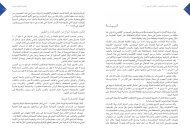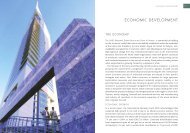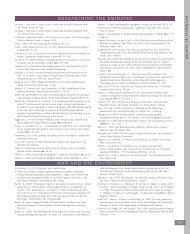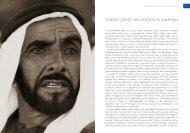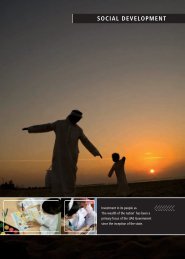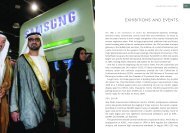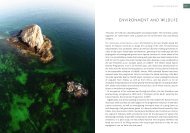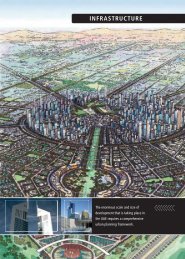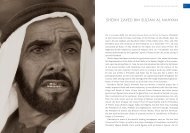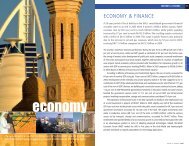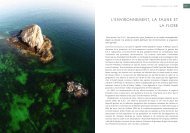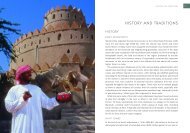Create successful ePaper yourself
Turn your PDF publications into a flip-book with our unique Google optimized e-Paper software.
<strong>HISTORY</strong> & <strong>TRADITIONS</strong>‘He who does not know his pastcannot make the best of hispresent and future, for it is fromthe past that we learn.’
9<strong>HISTORY</strong> & <strong>TRADITIONS</strong>Preserving the heritage andtraditions of the past is a keyfocus of Government policy.THE <strong>UAE</strong> HAS A LONG <strong>HISTORY</strong> stretching back over 100,000 years,stone tools from the Early Stone Age having been found recentlyalong the edge of the Hajar Mountains. Prior to this the earliestknown human occupation for which there is significant evidencedated from the Neolithic period, 5500 BC or 7500 years ago, whenthe climate was wetter and food resources abundant. Even at thisearly stage, there is proof of interaction with the outside world,especially with civilisations to the north. These contacts persistedand became wide-ranging, probably motivated by trade in copperfrom the Hajar Mountains, as the climate became more arid andfortified oasis communities focused on agriculture.Foreign trade, the recurring motif in the history of this strategicregion, seems to have flourished also in later periods, facilitated bydomestication of the camel at the end of the second millennium. Atthe same time, the discovery of new irrigation techniques (falajirrigation) made possible the extensive watering of agriculturalareas that resulted in an explosion of settlement in the region.By the first century AD overland caravan traffic between Syriaand cities in southern Iraq, followed by seaborne travel to theimportant port of Omana (probably present-day Umm al-Qaiwain)and thence to India was an alternative to the Red Sea route used bythe Romans. Pearls had been exploited in the area for millennia butat this time the trade reached new heights. Seafaring was also amainstay and major fairs were held at Dibba bringing merchantsfrom as far afield as China.The arrival of envoys from the Prophet Muhammad in 630 ADheralded the conversion of the region to Islam with Dibba againfeaturing, this time as a battleground in the wake of the Prophet’sdeath. By 637 AD Islamic armies were using Julfar (Ra’s al-Khaimah)as a staging post for the conquest of Iran. Over many centuries,Julfar became a wealthy port and pearling centre of considerableimportance from which great wooden dhows ranged far and wideacross the Indian Ocean.The earliestknown inhabitantsof the <strong>UAE</strong> seemto have arrived inthe Early StoneAge, over 100,000years ago. Theirstone tools havebeen found alongthe edge of theHajar Mountains.Many stone tools havebeen found in the <strong>UAE</strong>.@www.uaeinteract.com/uaehistory
IMPORTANT DATES10 <strong>HISTORY</strong> & <strong>TRADITIONS</strong>11c.5500 BC5500–3000 BC3000–2500 BC2500–2000 BC2000–l300 BC1300–300 BC300 BC–00–250 AD240 AD6 th /7 th cent. AD630 AD632 ADEvidence of extensive human occupation in <strong>UAE</strong>.Occupation by skilled groups of herders using finely made stonetools (so-called ‘Arabian bifacial tradition’).Hafit period – era of earliest collective burials first noted on thelower slopes of Jebel Hafit in the interior of Abu Dhabi.Umm al-Nar period – era of first oasis towns (e.g. at Hili, TellAbraq, Bidiya, Kalba) dominated by large, circular fortresses; burial ofthe dead in round communal tombs; wide-ranging trade contact with Mesopotamia,Iran, Indus Valley, Baluchistan, Bactria (Afghanistan); first intensive use of copperresources of Hajar Mountains; area referred to as Magan in Mesopotamian sources.Wadi Suq period and Late Bronze Age – an era which is characterised by fewertowns; change in burial customs to long, generally narrow collective tombs; closeties to Dilmun (Bahrain).Iron Age – introduction of new irrigation technology inthe form of falaj (pl. aflaj), subterranean galleries whichled water from mountain aquifers to lower-lying oases andgardens; explosion of settlement; first use of iron; firstwriting, using South Arabian alphabet; contacts with Assyrianand Persian empires.Mleiha period (or Late Pre-Islamic A–B) – flourishing town at Mleiha; beginnings oflocal coinage; far-flung imports from Greece (black-glazed pottery), South Arabia(alabaster unguent jars); first use of the horse.Ed-Dur period (or late Pre-Islamic C–D) – flourishing towns at ed-Dur and Mleiha;extensive trade network along the Gulf linking up the Mediterranean, Syria andMesopotamia with India; imports include Roman glass, coinage, brass; massiveproduction of coinage by a ruler called Abi’el; first use of Aramaic in inscriptionsfrom ed-Dur and Mleiha.Rise of the Sasanian dynasty in south-western Iran, conquest of most of easternArabia.Introduction of Christianity via contacts with south-western Iran and southernMesopotamia; establishment of monastery on Sir Bani Yas by Nestorian Christiancommunity; Sasanian garrisons in inner Oman and evidence for contact in the <strong>UAE</strong>shown by coins and ceramics from Kush (Ra’s al-Khaimah), Umm al-Qaiwain andFujairah.Arrival of envoys from the Prophet Muhammad;conversion of the people to Islam.Death of the Prophet Muhammad; outbreak of the riddamovement, a widespread rebellion against the teachingsof Islam; dispatch of Hudhayfah b. Mihsan by the CaliphAbu Bakr to quell rebellion of Laqit b. Malik Dhu at-Tag atDibba; major battle at Dibba, collapse of the rebels.Julfar used as staging post for Islamic invasion of Iran.Julfar used as staging post for Abbasid invasion of Oman.Buyids (Buwayhids) conquer south-eastern Arabia.Geographer Yaqut mentions Julfar as a fertile town.Close commercial contact between Northern Emirates and kingdom of Hormuz,based on Jarun island in the Straits of Hormuz.Portuguese circumnavigation of Cape of Good Hope by Vasco da Gama using Arabnavigational information.Portuguese–Ottoman rivalry in the Gulf.Venetian traveller Gasparo Balbi’s description of coast of <strong>UAE</strong> from Qatar to Ra’sal-Khaimah; mention of Portuguese fortress at Kalba; first mention of Bani Yas inAbu Dhabi.Description of the East Coast of the <strong>UAE</strong> by a Dutch mariner sailing in the Meerkat.Growth of English trade in the Gulf; increasing Anglo–Dutch rivalry.Sharjah and most of Musandam and the <strong>UAE</strong> East Coast, all the way to KhorFakkan, under control of Qawasim according to Carsten Niebuhr, German surveyorworking with the King of Denmark’s scientific expedition.Repeated English East India Company attacks on Qawasim navy.General Treaty of Peace between British Government and sheikhs of Ra’s al-Khaimah,Umm al-Qaiwain, Ajman, Sharjah, Dubai and Abu Dhabi.Survey of the Gulf resulting in the publication of the first accurate charts and mapsof the area.Collapse of the natural pearl market; first agreements signed by rulers of Dubai,Sharjah and Abu Dhabi for oil exploration.Oil exploration agreements finalised in Ra’s al-Khaimah, Umm al-Qaiwain and Ajman.First export of oil from Abu Dhabi.British Government announced its intention to withdraw fromthe Gulf region; discussions begin on formation of afederation of the emirates.First export of oil from Dubai.Agreement reached amongst rulers of the emirates toform a union.Formation of the State of the United Arab Emirates.Sheikh Zayed, 1 st President of the <strong>UAE</strong> died.Sheikh Khalifa bin Zayed Al Nahyan elected as new Presidentof the <strong>UAE</strong>.637 AD892 AD963 ADc. 122014 th –15 th cent.149816 th cent.158016661720s17641800–181918201820–18641930s1945–195119621968196910 July 19712 Dec 19712 Nov 20043 Nov 2004
12 UNITED ARAB EMIRATES YEARBOOK 2007IBN MAJIDWe use 32 rhumbs and wehave tirfa, zam and qiyas(measurement of star attitude)but they are not able to dothese things nor can theyunderstand the things whichwe do although we canunderstand what they do andwe can use their knowledgeand travel in either ships.They acknowledge that wehave the better knowledge ofthe sea and its sciences and thewisdom of the stars in the highroads of the sea.For we divide the ship in lengthand breadth according to thecompass rose and we havemeasurements of star altitudes.They have no similar division orany means of dividing themfrom the prow of the ship toguide themselves; neither dothey use star altitudemeasurements to guide themwhen they incline to theright or left.Ibn Majid, the ‘Lion of the Sea’ and a legendary figure in<strong>UAE</strong> history, wrote the verse quoted opposite long beforeVasco da Gama ever rounded the Cape of Good Hope or setfoot in the Arabian lands from which Ibn Majid, his equallyskilled father, grandfather and other forebears had beensailing and exploring throughout their working lives. The‘they’ of whom he wrote were, of course, Europeans, and it istrue to say that the Arabs had sailed into European waterslong before the Europeans had mastered the art of crossingthe Indian Ocean. Born in Julfar, close to present-day Ra’s al-Khaimah, in around 1432–37, Ibn Majid came from a longline of intrepid sailors. His reputation as a navigator isbased upon 40 surviving works, 39 of which are in verse.Some are brief, others, such as the 805-verse al-Sofaliyadescribing the sea route from India to Sofala on theMozambique coast, are considerably longer. One treatise(the Fawa’id) is a lengthy opus that not only summarisesall of Ibn Majid’s own knowledge of navigation, but alsodraws extensively on the work of early Arab astronomers. Hislast-known poem was written in 1500 AD and it is believedthat he died soon after, at a little over 70 years of age.
14 UNITED ARAB EMIRATES YEARBOOK 2007<strong>HISTORY</strong> & <strong>TRADITIONS</strong>15A cannon outsidethe walls ofUmm al-Qaiwain FortThe Britishoffensive wasbased on a desireto control themaritime traderoutes between theGulf and India.The Portuguese arrival in the Gulf in the sixteenth century hadbloody consequences for the Arab residents of Julfar and East Coastports like Dibba, Bidiya, Khor Fakkan and Kalba. However, whileEuropean powers competed for regional supremacy, a local power,the Qawasim, were gathering strength. At the beginning of thenineteenth century they had built up a fleet of over 60 large vesseland could put nearly 20,000 sailors to sea, eventually provoking aBritish offensive to control the maritime trade routes between theGulf and India.Inland, the arc of villages at Liwa were the focus of economic andsocial activity for the Bani Yas from before the sixteenth century.But by the early 1790s the town of Abu Dhabi had become such animportant pearling centre that the political leader of all the Bani Yasgroups, the Sheikh of the Al Bu Falah (Al Nahyan family) movedthere from the Liwa. Early in the nineteenth century, members ofthe Al Bu Falasah, a branch of the Bani Yas, settled by the Creek inDubai and established Maktoum rule in that emirate.Following the defeat of the Qawasim, the British signed a series ofagreements with the sheikhs of the individual emirates that, lateraugmented with treaties on preserving a maritime truce, resulted inthe area becoming known as ‘The Trucial States’.The pearling industry thrived in the relative calm at sea duringthe nineteenth and early twentieth centuries, providing bothincome and employment to the people of the Arabian Gulf coast.Many of the inhabitants were semi-nomadic, pearling in thesummer months and tending to their date gardens in the winter.However, their meagre economic resources were soon to be dealt aheavy blow. The First World War impacted severely on the pearlfishery, but it was the economic depression of the late 1920s andearly 1930s, coupled with the Japanese invention of the culturedpearl, that damaged it irreparably. The industry eventually fadedaway just after the Second World War, when the newly independentGovernment of India imposed heavy taxation on pearls importedfrom the Gulf. This was catastrophic for the area. Despite theirresourcefulness, the population faced considerable hardship withlittle opportunity for education and no roads or hospitals.Fortunately oil was on the horizon and in the early 1930s the firstoil company teams arrived to carry out preliminary surveys and thefirst cargo of crude was exported from Abu Dhabi in 1962. Withrevenues growing as oil production increased, Sheikh Zayed binSultan Al Nahyan, who was chosen as Ruler of Abu Dhabi on 6August 1966, undertook a massive programme of construction ofschools, housing, hospitals and roads. When Dubai’s oil exportscommenced in 1969, Sheikh Rashid bin Saeed Al Maktoum, defacto Ruler of Dubai since 1939, was also able to use oil revenues toimprove the quality of life of his people.FEDERATIONAt the beginning of 1968, when the British announced theirintention of withdrawing from the Arabian Gulf by the end of 1971,Sheikh Zayed acted rapidly to initiate moves towards establishingcloser ties with the emirates. Along with Sheikh Rashid, who was tobecome Vice-President and Prime Minister of the newly formedstate, Sheikh Zayed took the lead in calling for a federation thatwould include not only the seven emirates that together madeup the Trucial States, but also Qatar and Bahrain. Following aperiod of negotiation however, agreement was reached betweenthe rulers of six of the emirates (Abu Dhabi, Dubai, Sharjah,Umm al-Qaiwain, Fujairah and Ajman) and the Federation to beknown as the United Arab Emirates (<strong>UAE</strong>) was formally establishedon 2 December 1971. The seventh emirate, Ra’s al-Khaimah,formally acceded to the new Federation on 10 February 1972.ZAYED AND THE <strong>UAE</strong>The prosperity, harmony and modern development thatcharacterises the United Arab Emirates, led today by PresidentHH Sheikh Khalifa bin Zayed Al Nahyan, also the Ruler of theEmirate of Abu Dhabi, and his fellow-members of the SupremeCouncil of Rulers of the seven emirates, is due to a very greatextent to the role played by Sheikh Zayed, both prior to theformation of the Federation and in the nearly 33 years thatfollowed until his death in November 2004. The achievements ofThe UnitedArab Emirateswas formallyestablished on2 December 1971.@www.uaeinteract.com/uaehistory
16 UNITED ARAB EMIRATES YEARBOOK 2007THE DISCOVERY OF OILIt is now over four decades since oil production first beganin the United Arab Emirates. The story of oil, however,goes back much further. In the 1930s, the consortium ofwhat became BP, Shell, Total, ExxonMobil and Partex,operating in Iraq as the Iraq Petroleum Company, turnedtheir eyes to the Lower Gulf. Over the next few years,several concession agreements were signed, of which themost important was that with Abu Dhabi in January 1939.To handle those in the Trucial States, as the <strong>UAE</strong> was thenknown, IPC established a subsidiary, Petroleum Development (Trucial Coast),PD(TC), which drilled its first well at Ra’s Sadr, north-east of Abu Dhabi, in 1951.Although dry, it was, at the time, the deepest well ever drilled in the Middle East.PD(TC) drilled several other wells before finding traces of hydrocarbons atMurban, (now known as Bab), south-east of Abu Dhabi, in 1954. With its third wellon this structure completed in 1960, PD(TC) declared the field commercially viableand it went into production in 1963. The company was later renamed the AbuDhabi Petroleum Company (ADPC).Meanwhile, in 1953, BP had negotiated an offshore concession, assigned to aspecially created subsidiary, Abu Dhabi Marine Areas Ltd (ADMA). Surveys werecarried out with the assistance of the famous French underwater explorer, JacquesCousteau. The first well was drilled on a structure called Umm Shaif in 1958,and struck oil in massive quantities. With Das Island as the export terminal, UmmShaif went into production in 1962.Since then, many more important fields have been identified, while the AbuDhabi National Oil Company (ADNOC), established in 1971, has now takencontrolling shares in the concessions, with ADMA being replaced as operator bythe Abu Dhabi Marine Operating Company (ADMA-OPCO) and ADPC by the AbuDhabi Company for Onshore Oil Operations (ADCO), although foreign shareholdersretain a share.Memories of the early days of exploration are now fading fast. The results ofthe efforts of those, both <strong>UAE</strong> nationals and expatriates, who took part, however,continue to define the economy of the United Arab Emirates today.
18 UNITED ARAB EMIRATES YEARBOOK 2007<strong>HISTORY</strong> & <strong>TRADITIONS</strong>19Sheikh Zayed on camelback photographed withhis falcon in 1949.Sheikh Zayed hada clear vision ofwhat he wantedto achieve.his career are well summed up elsewhere in this Yearbook, but abrief overview of his life and achievements is appropriate here.Born around 1918 in Abu Dhabi, Sheikh Zayed was the youngestof the four sons of Sheikh Sultan, Ruler of Abu Dhabi from 1922 to1926. He was named after his grandfather, Sheikh Zayed bin Khalifa.At the time that Sheikh Zayed was born, the emirate was poorand undeveloped and life, even for members of the ruling family,was simple.Throughout the late 1920s and 1930s, as Sheikh Zayed grewto manhood, he displayed an early thirst for knowledge that tookhim out into the desert with the bedu tribesmen and into the seawith the fishermen and pearl divers, to learn about the peopleand the environment in which they lived. He later recalled withpleasure his experience of desert life and his initiation into thesport of falconry, which became a lifelong passion.These travels provided Sheikh Zayed with a deep understandingboth of the country and of its people. In the early 1930s, when thefirst oil company teams arrived to carry out preliminary surfacegeological surveys, he obtained his first exposure to the industry.In 1946, Sheikh Zayed was chosen to fill a vacancy as Ruler’sRepresentative in the Eastern Region of Abu Dhabi, centred onthe oasis of Al Ain, approximately 160 kilometres east of theisland of Abu Dhabi itself. The job involved not only the task ofadministering the six villages but also the whole of the adjacentdesert region, enabling Sheikh Zayed to learn the techniques ofgovernment as well as deepening his knowledge of the tribes.Sheikh Zayed brought to his new task a firm belief in the valuesof consultation and consensus, in contrast to confrontation. Foreignvisitors, such as the British explorer Sir Wilfred Thesiger, who firstmet him at this time, noted with approbation that his judgements‘were distinguished by their acute insights, wisdom and fairness’.Sheikh Zayed swiftly established himself not only as someonewho had a clear vision of what he wished to achieve for thepeople of Al Ain, but also as someone who led by example.A key task in the early years in Al Ain was that of stimulatingthe local economy, which was largely based on agriculture. Healso ordered a revision of local water ownership rights to ensurea more equitable distribution, surrendering the rights of his ownfamily as an example to others.With development gradually getting under way, Sheikh Zayedcommenced the laying out of a visionary city plan, and orderedthe planting of ornamental trees that, now grown to maturity,have made Al Ain one of the greenest cities in Arabia.Despite the lack of government revenues, Sheikh Zayed succeededin bringing progress to Al Ain, establishing the rudiments of anadministrative machinery, personally funding the first modernschool in the emirate and coaxing relatives and friends to contributetowards small-scale development programmes. Oil production wasto provide Sheikh Zayed with the means to fund his dreams, withthe export of the first cargo of Abu Dhabi crude in 1962.On 6 August 1966, Sheikh Zayed succeeded his elder brotheras Ruler of Abu Dhabi, with a mandate from his family to pressahead as fast as possible with the development of Abu Dhabi.One of his early steps was to increase contributions to the TrucialStates Development Fund, while when, in February 1968, theBritish announced their intention of withdrawing from the ArabianGulf by the end of 1971, Sheikh Zayed acted rapidly to initiatemoves towards establishing closer ties with the emirates, theseefforts culminating in the establishment of the <strong>UAE</strong>. Sheikh Zayedwas elected by his fellow rulers as the first President of the <strong>UAE</strong>, apost to which he was successively re-elected at five-year intervals.The new state came into being at a time of political turmoil in theregion. A couple of days earlier, on the night of 30 November andthe early morning of 1 December, Iran had seized the islands ofGreater and Lesser Tunb, part of Ra’s al-Khaimah, and had landedtroops on Abu Musa, part of Sharjah (see section on Foreign Policy).Foreign observers, lacking an understanding of the importanceof a common history and heritage in bringing together the peopleof the <strong>UAE</strong>, predicted that the new state would survive only withdifficulty, pointing to disputes with its neighbours and to thewide disparity in the size, population and level of developmentof the seven emirates.@www.uaeinteract.com/uaehistorySheikh Zayed careddeeply about preservingthe cultural heritageof the <strong>UAE</strong>.Sheikh Zayed wasfounder of theUnited ArabEmirates and itsPresident foralmost 33 years.
20 UNITED ARAB EMIRATES YEARBOOK 2007<strong>HISTORY</strong> & <strong>TRADITIONS</strong>21Sheikh Zayedbelieved that all ofthe country’scitizens have a roleto play in itsdevelopment. Bothmen and women,he believed,should play theirpart.Better informed about the character of the country, Sheikh Zayedwas naturally more optimistic and the predictions of those earlypessimists were shown to be unfounded.During his years in Al Ain Sheikh Zayed had been able to developa vision of how the country should progress. Once Ruler of AbuDhabi, and then President, he had over three and a half decadesto devote to making that vision a reality.One foundation of his philosophy as a leader and statesmanwas that the resources of the country should be fully used to thebenefit of the people. He saw them to be not as a means untothemselves, but as a tool to facilitate the development of what hebelieved to be the real wealth of the country – its people, and, inparticular, the younger generation.Within this framework, Sheikh Zayed believed that all of thecountry’s citizens have a role to play in its development. Bothmen and women, he believed, should play their part. Recognisingthat in the past a lack of education and development had preventedwomen from playing a full role in much of the activity of society,he took action to ensure that this situation was addressed rapidlyand, under his leadership, the country’s women came increasinglyto play their part in political and economic life.Sheikh Zayed also believed in encouragement of initiativesdesigned to conserve the traditional culture of the people, in orderto familiarise the younger generation with the ways of theirancestors. In his view, it was of crucial importance that the lessonsand heritage of the past were remembered.He who does not know his past cannot make the best of his presentand future, for it is from the past that we learn. We gain experienceand we take advantage of the lessons and results [of the past].If the heritage of the people of the <strong>UAE</strong> was important to SheikhZayed, so too was the conservation of its natural environment.His belief in conservation derived from his own upbringingwhere a sustainable use of resources required man to live inharmony with nature. This led him to ensure that conservationof the environment was a key part of government policy.As in other areas of national life, Sheikh Zayed made it clear thatconservation is not simply the task of government. He believedfirmly that there was also a role for the individual and for nongovernmentalorganisations, both of citizens and expatriates,applying this belief not just to concerns such as environmentalconservation, but to other areas of national life as well.Sheikh Zayed imbibed the principles of Islam in his childhoodand they remained the foundation of his beliefs and principlesthroughout his life. He was a firm and dedicated opponent ofthose who sought to pervert the message of Islam to justify harshdogmas, intolerance and terrorism. In Sheikh Zayed’s view,however, such an approach was not merely a perversion of themessage but is in direct contradiction of it. Extremism, he believed,has no place in Islam. In contrast, he stressed that:Islam is a civilising religion that gives mankind dignity. A Muslimis he who does not inflict evil upon others. Islam is the religion oftolerance and forgiveness, and not of war, of dialogue andunderstanding. It is Islamic social justice which has asked everyMuslim to respect the other. To treat every person, no matter whathis creed or race, as a special soul is a mark of Islam. It is just thatpoint, embodied in the humanitarian tenets of Islam, that makesus so proud of it.He recognised, however, the necessity not only of eradicatingterrorism, but of tackling its fundamental causes. Besides theinternational campaign against the types of terrorism, there should,he believed, be a strong international alliance that worked, inparallel, to exert real and sincere efforts to bring about a just andlasting solution to the Middle East conflict.Sheikh Zayed was also an eager advocate of tolerance, discussionand a better understanding between those of different faithsand, in particular, was an ardent advocate of dialogue betweenMuslims and Christians.In the realm of the foreign policy of the state, his firmly-heldbelief in eschewing rhetoric in the search for solutions led the<strong>UAE</strong> to adopt an approach of seeking to find compromises, and toAbu Dhabi’s ‘WhiteFort’ was the seat ofregional governmentand home of previousrulers of the emirate.Sheikh Zayedrecognised thenecessity of notonly eradicatingterrorism but alsoof tackling itsfundamentalcauses.@www.uaeinteract.com/uaehistory
22 UNITED ARAB EMIRATES YEARBOOK 2007<strong>HISTORY</strong> & <strong>TRADITIONS</strong>23A decorated red jar fromthe Umm al-Nar period,found at Tell Abraq.avoid, wherever possible, a resort to the use of force, whether inthe Arab arena or more widely. Under his leadership, therefore, thecountry became an important provider of overseas aid, both forthe development of infrastructure and for humanitarian relief,whether provided through civilian channels, as in the case of thereconstruction of Iraq following the defeat of the Saddam Husseingovernment in 2003 or, occasionally, by sending units of the<strong>UAE</strong> Armed Forces as international peacekeepers, such as toKosovo in the late 1990s.At the same time, the <strong>UAE</strong>, under his leadership, showed itspreparedness to fight to defend justice, as was seen by its activeparticipation in the war to liberate Kuwait from occupation in1990–1991.ARCHAEOLOGY REVIEWSince the formal study of the archaeology of the <strong>UAE</strong> began, nearly50 years ago, there has been one major query about the resultsfrom surveys and excavations that have taken place. Substantialevidence of human occupation in the past has been identified,stretching back into the Neolithic, or Late Stone Age, period, whichcommenced around 5500 BC, or 7500 years ago. Archaeologistshave always considered it likely that ancient man was living inthe Emirates long before that, but no sites had been found, andit was thought that any traces of earlier occupation must havebeen buried beneath the dunes, or under gravel and stoneswashed out by thousands of years of rainfall.Over the course of the last year, however, evidence of earlieroccupation, in the Palaeolithic period, going back many tens ofthousands of years, has finally been found. The discoveries weremade at Jebel Faiyah, a rocky outcrop in the east of Sharjah, by ateam from Sharjah’s Directorate of Antiquities and Germany’sUniversity of Tubingen, and were first announced at the annualSymposium on Recent Palaeontological and ArchaeologicalDiscoveries in the <strong>UAE</strong>, organised by the Zayed Centre for Historyand Heritage.The site was used during several periods, with evidence of IronAge occupation near the surface, some Bronze Age material justbelow that, and then artefacts from the Neolithic period at adepth of between 40 and 70 centimetres under the present surface.The joint Sharjah & Tubingen team then excavated to a total depthof over 2 metres beneath the present surface, finding around ametre of deposits below the Neolithic artefacts in which there wasno evidence of occupation at all. Around 170 to 180 centimetresbeneath the present surface, however, they found several flinttools that had clearly been worked by Man. Efforts to date thesite properly are continuing, and further investigation is planned.But the archaeologists have assigned a provisional date in theearly part of the Upper Pleistocene, which began around 125,000years ago, and ended around 10,000 years ago, when today’s eraof geological time, known as the Holocene, began. Nothing more isyet known about these early inhabitants of the Emirates, but asearch is now under way for further sites of the same period.While this discovery is the most significant to have been madeover the last year in terms of studying the <strong>UAE</strong>’s past, there havebeen other important finds as well. Going back beyond thePleistocene, to the Late Miocene period, around 6 to 8 millionyears ago, another site with fossil bones has been identified atUmm al-Ishtan, in the far west of the country. The bones werefirst discovered by animal rangers from the Environmental Agency– Abu Dhabi (EAD) who reported them to President HH SheikhKhalifa bin Zayed Al Nahyan in late 2005. The President promptlyordered an investigation, and a team from the Abu DhabiIslands Archaeological Survey (ADIAS) paid a visit to discoverthat the bones were not from camels, as the rangers had thought,but from the primitive elephant Stegotetrabeladon syrticus. Severalbones have now been excavated and will eventually go on displayin Abu Dhabi.The presence of this ancient elephant in western Abu Dhabi wasalready known, but the Umm al-Ishtan site is much further inlandthan any other Late Miocene site, showing, yet again, that thereis still much to discover about the <strong>UAE</strong>’s past.A hoard of coins fromthe eleventh centuryAD. This is one ofseveral such hoardsfound in the <strong>UAE</strong>.It is on display atAl Ain Museum.@www.uaeinteract.com/archaeology
24 UNITED ARAB EMIRATES YEARBOOK 2007The Abu DhabiAuthority forCulture andHeritage isplanning a unifiedapproach to thestudy of AbuDhabi’s past.More work by ADIAS, in association with the Department ofAntiquities and Tourism in Al Ain, (now part of the new Abu DhabiAuthority for Culture and Heritage, ADACH), focused on Neolithicsites near Umm az-Zamul, in the south-eastern deserts of AbuDhabi, where around 3000 individual stone artefacts have nowbeen collected and mapped. One interesting discovery was apossible tomb of a type not previously recorded in the Emirates.Other work has taken place in Abu Dhabi’s eastern city of AlAin where a team from France’s Centre Nationale des RecherchesScientifiques (CNRS), working in association with the Departmentof Antiquities and Tourism, has undertaken an eighth year ofexcavations at a pit-grave at Hili that dates to the late Umm al-Narperiod, just over 4000 years ago. The many hundreds of skeletonsthat have been recovered from the grave, as well as other associatedmaterial, has provided valuable data on the diet, health andcustoms of the people.Although archaeologists have continued to devote attention toparticular sites, of varying periods, a major current focus is ontrying to understand the landscapes in which they are found,and assessing how these have evolved over thousands of years.One recent study has been of the bay of Dhayah, in northernRa’s al-Khaimah, which provides a cross-section through the coast,mangroves, palm gardens, gravel fans and mountains. Resultsshow that the area has been occupied since at least the Hafit period(around 3200–2500 BC) onwards, with sites from the Wadi Suqperiod in the early second millennium BC, the Iron Age and intothe Late Islamic period.Further studies of landscapes and theirarchaeological sites will play a major part in building up a morecomplete picture of the <strong>UAE</strong>’s history and heritage.Finally, re-structuring of Abu Dhabi’s government during late2005 and early 2006 saw the creation of the Abu Dhabi Authorityfor Culture and Heritage (ADACH), which is now planning aunified approach to the study of Abu Dhabi’s past, includingplans for what will be the capital city’s first – and long-awaited –museum. The Authority has absorbed the former Department ofAntiquities and Tourism.Before the Oil Age life in the <strong>UAE</strong>was ordered by the seasons.Falcons, salukis, camels andhorses were integral elements indaily life of the Emirati people.
26 UNITED ARAB EMIRATES YEARBOOK 2007THE CAMELUniquely adapted to the desert, the camel was the mainstay of the semi-nomadiclifestyle that was practiced by many of the <strong>UAE</strong>’s inhabitants. The largest tribe inthe <strong>UAE</strong>, the Bani Yas, roamed the vast sandy areas that cover almost all of theemirates of Abu Dhabi and Dubai. Other tribes, too, such as the Awamir andManasir, shared this challenging environment for numerous generations,guarding their valuable knowledge of where to obtain water in the harshterrain. The camel was both the reason for these lengthy excursions and themeans by which they were carried out. Long periods were spent wanderinggreat distances in search of winter grazing provided by dormant vegetationbrought to life by intermittent rainfall. Once the arid summer approached, almostall the Bani Yas families, with the exception of fishing groups like the AlRumaithat, returned to a home in one of the oasis settlements, many to tendand harvest their date gardens. Camel owners who had sufficient summergrazing close to their date palms were particularly fortunate as they could harvestwhilst watering their livestock at the wells that supplied the local communities.The camel was not just a useful mount and means of transporting possessionsand goods on long treks across inhospitable terrain; it also provided food, clothing,household items and recreation, and at the end of the day was a primary sourceof wealth. In many cases camel milk and the products derived from it were theonly protein available to bedu families for months on end. The camels were capableof surviving for long periods without water, but it was camels’ milk that quenchedthe herders’ thirst. Young male camels were slaughtered on special occasions toprovide meat for feasts and informal camel races were held during the festivities.Camel hide was used to make bags and other useful utensils, while tents, rugsand items such as fine cloaks (bisht) were woven from camel hair.
28 UNITED ARAB EMIRATES YEARBOOK 2007THE DATE PALMOver the centuries, bedu families that had spent the winter searching for grazing fortheir camels returned in the summer to the oasis gardens in the hollows of thedunes to harvest the date crop.The date palm was traditionally propagated from side shoots that grow out fromthe base of a mature trunk. Today, tissue culture techniques are also used topropagate plants. In each case, the outer branches sprouting at ground level aretrimmed every year and as the tree grows these branches are cut higher up, untileventually the trunk is formed. After three or more years, depending on the amountof available water, the date palm will flower in spring; flowers of the female treemust then be hand-pollinated with the panicles from a male tree, of which onlyvery few are planted. Harvesting takes place during the hottest period of the year,between late June and early October, depending on the type of date tree – there aremore than 50 varieties in the <strong>UAE</strong> alone.Not so long ago, the harvested dates were essential for survival. Ripe dates werelightly boiled and compressed into a congealed substance called tamr that can be keptalmost indefinitely because the high sugar content acts as a preservative. The driedpalm fronds were plaited into containers in which the nourishing, vitamin-richstaple diet could be taken on journeys through the desert, into the mountains, or outto sea. The dates were also stacked in small storerooms with underlying drainage forcollecting valuable date syrup. Palm fronds were used to build the walls and roofs of‘arish houses and as roof matting for the more sturdy coral-block constructions.Trunks supported the roofs of mudbrick and stone castles and towers. Even boats(canoe-like shashah) were made from the midrib of the palm frond. The palm trunkwas also hollowed out to form a mortar for crushing wheat with the tree stumpshaped into a pestle.
30 UNITED ARAB EMIRATES YEARBOOK 2007PEARLINGPearling has been an important economic activity in the region since ancient times,but the trade fluctuated throughout the centuries. At the end of the nineteenthcentury pearling was flourishing yet again, and an increasing number of ablebodiedmen participated in diving expeditions (ghaus) during four months in thesummer, those of the Liwa-based subtribes of the Bani Yas migrating ‘home’ totend their date gardens further inland in the winter. By the beginning of thetwentieth century there were, according to one calculation, over 1200 pearlingboats operating out of the area now known as the <strong>UAE</strong>, each carrying an averagecrew of 18 men. The pearling fleet leaving harbour must have been a wonderfulsight, but this level of participation meant that during the summer more than22,000 men were absent on the pearl banks. Long periods away from homeplaced enormous responsibility on the women of the family, both economicallyand socially.For the men, conditions on board the pearling boats were tough and the workwas arduous. The profits from a good season’s harvest made it all worthwhile,but bad seasons were followed by spiralling debt. Many of the Bani Yas menformed cooperatives, all the crew jointly owning a boat and sharing the proceedsof the sale of the pearls according to an established arrangement: the biggestshare to the captain (nakhuda), a larger share to the divers than the haulers, andsome money left aside to finance preparations for the following year. Over severalgenerations, some tribes involved in pearling became tied to particularlocations, and coastal towns such as Abu Dhabi, Dubai and Ra’s al-Khaimahthrived. All were badly affected by the collapse of pearl markets in the 1940s.
32 UNITED ARAB EMIRATES YEARBOOK 2007FALCONRYFalconry, once an important means ofsupplementing the diet of the <strong>UAE</strong>’sdesert inhabitants, is now enjoyed as atraditional pastime. The most popularhunting birds remain the saker falconand the peregrine falcon. These weretraditionally trapped along the coastduring their autumn migration, trained,used for hunting, and then released inthe spring.Once the falconers managed to captureone of the highly prized birds, they hadonly two to three weeks to train it beforethe migrating houbara bustards startedto arrive. This was done by developing astrong bond of trust between a wildcaptured bird and its handler, a uniqueskill that commands the respect of falconers worldwide. Ideally, the training of thefalcon was completed by the day when the first houbara arrived and the bedouinwould hunt the bustards with his falcon throughout the winter months. Althoughhoubara were the favoured quarry, falcons were also used in the past to take stonecurlews and hares, and sometimes with salukis to hunt gazelle.Today, many birds are caught abroad and imported. In fact, most falconrynow takes place outside the Emirates, and the <strong>UAE</strong> is a leader in research intoconservation of falcons.
34 UNITED ARAB EMIRATES YEARBOOK 2007INTERNET LINKSAbu Dhabi Culture and Heritage Authority: .........Abu Dhabi Islands Archaeological Survey: ..........Al Ain Museum: ..................................................Archaeology: .......................................................Arts: ....................................................................Culture: ...............................................................Falconry: ..............................................................Heritage: .............................................................History: ................................................................Monuments: ........................................................Museums: ............................................................Ramadan: ............................................................Salukis: ................................................................Theatre: ...............................................................Traditions: ...........................................................www.uaeinteract.com/adchawww.adias-uae.com/www.aam.gov.ae/www.uaeinteract.com/archaeologywww.uaeinteract.com/artswww.uaeinteract.com/uaeculturewww.uaeinteract.com/falconrywww.uaeinteract.com/heritagewww.uaeinteract.com/uaehistorywww.uaeinteract.com/monumentswww.uaeinteract.com/museumswww.uaeinteract.com/ramadanwww.uaeinteract.com/salukiswww.uaeinteract.com/theatrewww.uaeinteract.com/tradition



